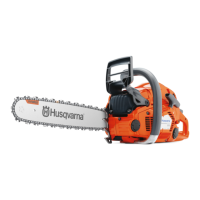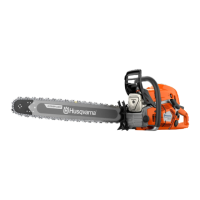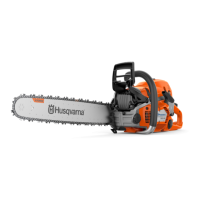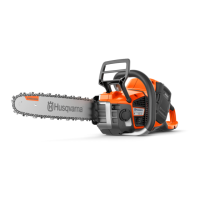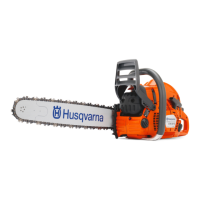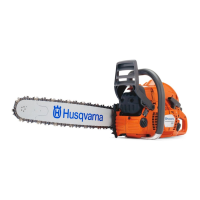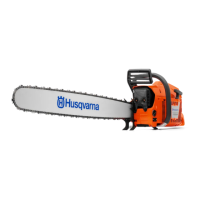Do you have a question about the Husqvarna 550 XP and is the answer not in the manual?
Explains symbols displayed directly on the chainsaw for operational guidance and safety.
Details symbols used within the operator's manual to convey instructions and warnings.
A detailed diagram and list identifying all major components of the chain saw.
Crucial initial steps and checks before operating the chainsaw for the first time.
Highlights critical safety advice and general responsibilities for the user.
Emphasizes exercising caution, seeking expert advice, and staying within personal capabilities.
Details the mandatory protective gear required for safe chain saw operation.
Explains the function and importance of the chainsaw's built-in safety features.
Describes the operation and function of the chain brake and its interaction with the front hand guard.
Explains the function of the throttle lockout mechanism to prevent accidental throttle engagement.
Describes the purpose of the chain catcher to retain the chain if it snaps or jumps off.
Details the role of the right hand guard in protecting the user's hand and preventing interference.
Explains the system designed to reduce vibration during operation for user comfort.
Instructions on how to use the stop switch to turn off the engine safely.
Details the function of the muffler in noise reduction and directing exhaust fumes.
Guidance on selecting and maintaining cutting equipment for optimal performance and safety.
Basic guidelines for using recommended cutting equipment and maintaining sharp teeth.
Focuses on choosing and using cutting equipment to minimize the risk of kickback.
Explains how guide bar characteristics, like tip radius, affect kickback risk.
Discusses saw chain types, including low-kickback versions, and their role in safety.
Defines key terms related to guide bars and saw chains for proper maintenance and selection.
Provides instructions on how to sharpen cutting teeth and adjust depth gauge for optimal performance.
Essential tips for sharpening chain teeth, including using the correct tools and technique.
Step-by-step guide on how to sharpen the cutting teeth of the saw chain.
Guidance on adjusting the depth gauge to ensure correct cutting depth and performance.
Detailed steps for adjusting the depth gauge setting using specific tools.
Instructions on how to properly tension the saw chain to prevent it from jumping off.
Explains the importance of proper lubrication for cutting equipment and chain oil.
Guidance on filling the chain oil tank, ensuring correct oil type and quantity.
How to check if the chain is receiving adequate lubrication during operation.
Information on the chain drive sprocket, including wear checks and replacement.
Details on lubricating the needle bearing in the clutch drum regularly.
Daily checks for wear on the saw chain and guide bar to ensure safety and performance.
Procedures for checking the guide bar for burrs, worn grooves, and uneven tips.
Detailed guide on how to correctly mount the guide bar and saw chain onto the saw.
Guidelines on selecting the correct gasoline type, octane rating, and mixing with oil.
Instructions on the correct procedure for mixing gasoline and two-stroke oil.
Recommendations for chain oil selection, viscosity, and avoiding waste oil.
Safety precautions and steps for refueling the chain saw correctly and safely.
Critical safety rules to follow when handling fuel, including ventilation and leak checks.
Guidelines for safely transporting and storing the chain saw and fuel.
Procedures for preparing the machine for extended periods of storage.
Detailed steps for starting both cold and warm engines, including safety checks.
Instructions on how to properly shut down the chain saw engine after use.
A checklist of pre-operation checks to ensure the saw is safe and ready for use.
Basic safety rules and guidance for general chain saw operation.
Fundamental safety practices to follow during chain saw operation.
Explains fundamental techniques for cutting wood with a chain saw safely.
Defines key terms used in cutting techniques, like cutting, limbing, and splitting.
Safety precautions and techniques specific to removing branches from a felled tree.
Introduces the complex process of felling trees, emphasizing experience and safety.
Specifies the safe distance to maintain from a tree during felling operations.
Factors influencing tree felling direction and planning for safe fall.
Steps to safely clear the trunk and establish a retreat path before felling.
Outlines the three-cut process for felling a tree with controlled direction.
Details on making directional cuts to guide the tree's fall accurately.
Instructions for making the final felling cut to complete the tree removal.
Addresses the dangerous situation of freeing a trapped or badly fallen tree.
Techniques for safely cutting wood under tension to prevent springback.
Provides crucial information and techniques to prevent dangerous kickback incidents.
Defines kickback and explains the specific conditions that cause it.
Methods for safely cutting the tree trunk into manageable logs.
Outlines the scope of user-performed maintenance versus professional servicing.
Information on carburetor function, including AutoTune and engine adjustment.
Procedures for inspecting and maintaining critical safety features like the chain brake.
Specific checks for the chain brake band wear and front hand guard integrity.
How to test the inertia-activated chain brake mechanism.
Procedure to check the proper functioning of the chain brake trigger mechanism.
Verifies the condition and movement of the right-hand brake trigger.
Checks related to the throttle lockout, ensuring it functions correctly with the throttle control.
Checks to ensure the chain catcher is undamaged and securely attached.
Inspections to confirm the right hand guard is not damaged and has no visible defects.
Regular checks for cracks or deformation in vibration damping units and secure attachment.
Verifies that the engine stops correctly when the stop switch is moved to the off position.
Emphasizes avoiding use of a machine with a faulty muffler and checking its attachment.
Instructions for replacing a damaged or worn starter cord, including safety precautions.
Steps for correctly tensioning the recoil spring when fitting or replacing the starter.
Procedures for changing a broken recoil spring, including safety considerations.
Guide for correctly installing the starter assembly onto the crankcase.
Importance of regular cleaning and replacement of the air filter to prevent engine issues.
Guidance on checking, cleaning, and replacing the spark plug for optimal engine performance.
Instructions for lubricating the bar tip sprocket each time you refuel.
Details on lubricating the needle bearing in the clutch drum regularly.
How to adjust the oil pump for optimal chain lubrication flow.
Importance of keeping the cooling system clean to prevent engine overheating.
Explains the centrifugal cleaning system and its maintenance requirements.
Specific measures and adjustments for operating the chain saw in cold and snowy conditions.
Information on the operation of heated handles for improved comfort in cold weather.
Details on the electrically heated carburetor to prevent ice formation.
Routine checks and cleaning to be performed daily for optimal saw operation.
Maintenance tasks recommended for weekly performance to ensure longevity.
Scheduled maintenance actions to be carried out on a monthly basis.
Technical specifications related to the engine, including displacement, bore, and stroke.
Details about the ignition system, including spark plug type and electrode gap.
Specifications for fuel and oil tank capacities, and oil pump capacity.
Technical details on chain and bar specifications, including length, pitch, and drive link thickness.
Lists recommended guide bars and saw chains for specific Husqvarna models in the USA.
Provides information and specifications for saw chain filing angles and file gauges.
Outlines the responsibilities of the owner and manufacturer regarding the emission warranty.
Specifies the duration and scope of the warranty coverage for emission-related parts.
Lists the owner's duties for maintaining the engine to ensure warranty validity.
Details which parts and services are included under the warranty coverage.
Clarifies exclusions from warranty coverage, such as abuse or neglect.
Lists specific engine components covered under the emission control system warranty.
Reinforces the owner's responsibility for performing all required maintenance.
General safety advice for chain saw operators, emphasizing user responsibility.
Specific safety measures to prevent injury from kickback incidents.
Additional safety advice covering fatigue, protective gear, fuel handling, and operating conditions.
| Cylinder Displacement | 50.1 cm³ |
|---|---|
| Sound Power Level | 116 dB(A) |
| Bar Length | 13-20 inches |
| Fuel Tank Volume | 0.52 liters |
| Oil Tank Volume | 0.27 liters |
| Chain Gauge | 0.05 inch |
| Weight | 5.3 kg |
| Chain Pitch | 0.325 inch |

